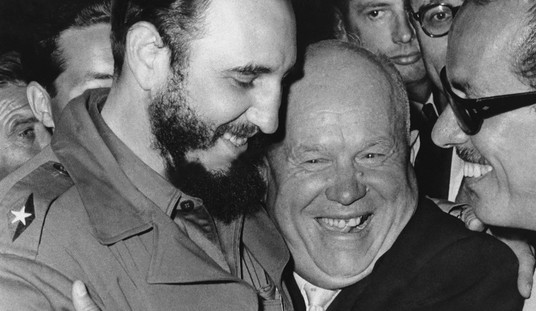Two months ago, Hillary Clinton met with FBI agents to explain why she set up a secret, unauthorized e-mail server that transmitted highly classified information about national security. Today, she visited the local FBI office to get a first-hand look at highly classified information about national security. To quote the great Yakov Smirnov: America — what a country, eh?
Hillary Clinton arrived Saturday morning at the FBI‘s satellite office in suburban New York City for her first national security briefing as the Democratic nominee for president.
Clinton arrived at the office in White Plains, New York, which is roughly 20 minutes from her Chappaqua home, about 9 a.m. Her campaign has not said who is attending the meeting with her.
Any attendees aside from the presidential candidate have to hold the necessary security clearances.
This part of the report from ABC News holds a particular irony:
Because of the sensitivity of the information discussed during presidential candidate briefings, the sessions must take place in locations with secure rooms, known as Sensitive Compartmented Information Facilities (SCIFs). The FBI’s office in White Plains has such rooms.
What a coincidence! The information that passed through Hillary’s e-mail server also required a SCIF to review … and a secured e-mail system to transmit. That didn’t stop Hillary from using a non-secure and unauthorized system and demanding that all her e-mail traffic pass through it, resulting in the “extremely careless” transmission of national-security information, as James Comey put it in his statement days after Hillary’s previous visit to the FBI, emphases mine:
From the group of 30,000 e-mails returned to the State Department, 110 e-mails in 52 e-mail chains have been determined by the owning agency to contain classified information at the time they were sent or received. Eight of those chains contained information that was Top Secret at the time they were sent; 36 chains contained Secret information at the time; and eight contained Confidential information, which is the lowest level of classification. Separate from those, about 2,000 additional e-mails were “up-classified” to make them Confidential; the information in those had not been classified at the time the e-mails were sent. …
With respect to the thousands of e-mails we found that were not among those produced to State, agencies have concluded that three of those were classified at the time they were sent or received, one at the Secret level and two at the Confidential level. There were no additional Top Secret e-mails found. Finally, none of those we found have since been “up-classified.” …
Although we did not find clear evidence that Secretary Clinton or her colleagues intended to violate laws governing the handling of classified information, there is evidence that they were extremely careless in their handling of very sensitive, highly classified information.
For example, seven e-mail chains concern matters that were classified at the Top Secret/Special Access Program level when they were sent and received. These chains involved Secretary Clinton both sending e-mails about those matters and receiving e-mails from others about the same matters. There is evidence to support a conclusion that any reasonable person in Secretary Clinton’s position, or in the position of those government employees with whom she was corresponding about these matters, should have known that an unclassified system was no place for that conversation. In addition to this highly sensitive information, we also found information that was properly classified as Secret by the U.S. Intelligence Community at the time it was discussed on e-mail (that is, excluding the later “up-classified” e-mails).
SCIFs are required to review and discuss top secret and special-access program information, which gives us an idea of the sensitivity of today’s discussions. How did someone shown to have exhibited such “carelessness” over a four-year period — and who still lies to this day about it — gain access to a classified briefing of even more and newer TS and TS/SAP intel? Well, we can thank Democratic primary voters for that, because all major-party nominees get exactly this kind of briefing. And if Hillary wins the election, she not only will have access to all of this information, she can protect herself by declassifying it if she gets caught fumbling it again.
As I wrote this week at The Fiscal Times, we will have no one but ourselves to blame if that comes to pass:
Expect more revelations to flow out of the e-mails and Clinton Foundation records. Just don’t expect it to make much of a difference. Questions have been raised about connections between the Clinton Foundation and the State Department for years. Hillary Clinton’s attempt to circumvent legitimate Congressional and judicial oversight of State Department operations by hiding communications in an unauthorized and non-secure e-mail system is a brazen corruption of constitutional authority, and yet it hardly put a dent in her race to the nomination.
We have moved beyond character and morals in American society to an entirely transactional kind of politics. Not only do people no longer value character and integrity, but we have also become almost hostile to the proposition that they matter at all. If those values still mattered to American voters, we would not have the two least-favorable candidates in either party as nominees for the presidency.
We are about to spend the next several years learning a very hard lesson in why character and integrity matter in public office and public life. Perhaps it will awaken us from the stupor of moral relativism that reduces every interaction to the strictly transactional.









Join the conversation as a VIP Member